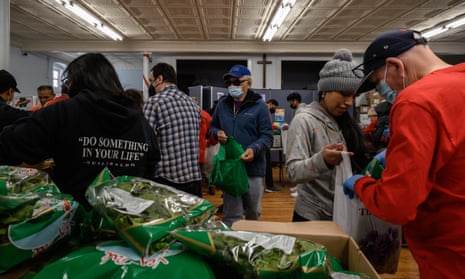One in 10 American households struggled to feed their families last year, with more than 5 million families missing meals and cutting portions due to poverty, new government research reveals.
Food insecurity in households with children is the lowest level on record, yet families still account for almost half of the country’s food-insecure households, with 2.3m unable to afford adequate nutritional food at times during 2021, according to the annual food insecurity report by the USDA.
In most circumstances, adults went without to ensure the children were adequately fed, but for 0.7% of extremely poor households there was not enough food for anyone. In the richest country in the world, children in 274,000 American households went hungry, skipped meals or did not eat for entire days because there was not enough money to buy food.
Inadequate nutrition can affect children’s growth and physical development, as well as their ability to thrive, play and learn.
Food insecurity remains stubbornly high in the US, with only a slight downward trend from 2021 – but significantly lower than 2020 when the Covid shutdown and widespread layoffs led to record numbers of Americans relying on food banks and food stamps to get by.
For some groups, things got worse last year compared to 2021, according to the USDA survey that found higher levels of food insecurity in adult-only households especially for women and elderly people living alone. But there were year-on-year drops for several population sub-groups, including households with children under six, single mothers with children, Black families and households in the south.
“There is a lot of good news in this report especially for families with children, and these year-on-year improvements likely reflected a combination of falling unemployment and the child tax credit,” said Diane Whitmore Schanzenbach, director of the Institute for Policy Research at Northwestern University.
But a lot has changed this year, and even these small gains could be reversed.
The latest USDA findings come as the US teeters on the brink of recession, with the cost of food soaring due to double-digit inflation. The climate breakdown and Russia’s war in Ukraine are pushing up food prices, and the cost of groceries in July was up 13.1% compared to last year, with the price of cereal, bread and dairy products rising even higher, according to the Consumer Price Index.
Households are also under more pressure as states roll back pandemic-linked financial support such as free school meals for every child, child tax credits and many states now stopping expanded food stamp benefits.
Realtime data from the US Census survey “suggest that food hardship has been steadily rising in families with children this year”, said Whitmore Schanzenbach.
Food insecurity and unequal access to grocery stores play a major role in a range of public health epidemics, including obesity, diabetes, heart disease and tooth decay, as unhealthy processed foods with high levels of fat and sugar are often cheaper and more accessible than healthier options.
Later this month, the White House will host a conference on hunger, nutrition and health – the first such event in more than 50 years. It is unclear whether the conference will address the root causes of America’s food insecurity epidemic, which experts say is fundamentally an economic and racial justice issue.
Every month, millions of Americans are forced to choose between paying for rent, healthcare, bills, childcare and groceries, because they are not paid a living wage. One in four Americans rely on federal nutrition assistance such as food stamps and free school lunches. The rates are higher among Indigenous, Black and Latino households.
Food insecurity has never fallen below 10% since 2000, peaking during the aftermath of the 2007 housing market collapse. Older Americans are still experiencing higher levels of food insecurity than before the Great Recession.
